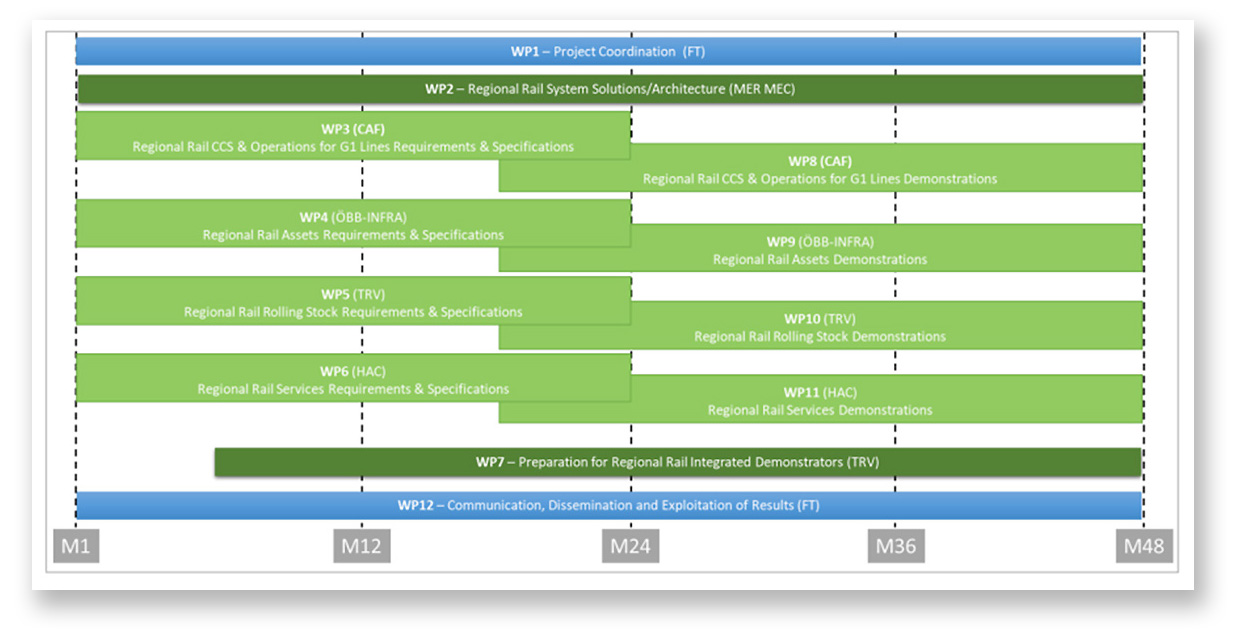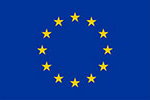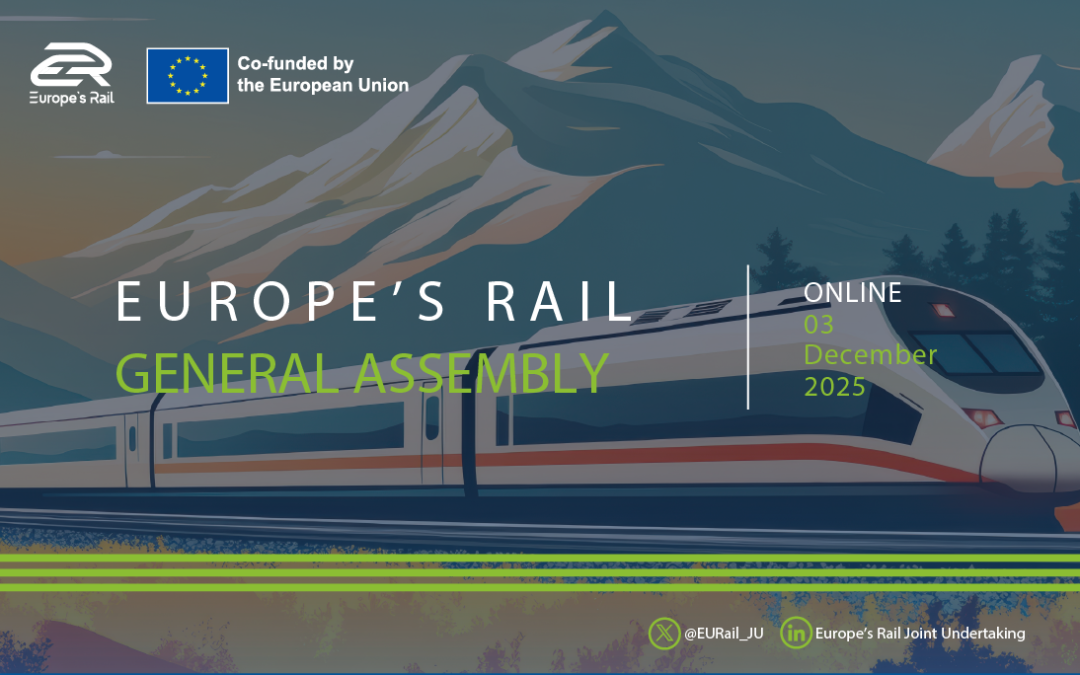FP2-R2DATO D21.2: System requirements of ASTP system FP2-R2DATO advances rail safety and efficiency by developing the...
Project structure

WP01 Project Coordination
WP02 Regional Rail System Solutions/Architecture
Regional Rail System Solutions/Architecture
coordinates the work on system architecture of all WPs as well as ensuring exchange, alignment and harmonization with System Pillar and other FP projects. It will analyse the operational and functional system architecture for application on G1 lines to obtain the best and the lowest cost solution compatible with the ERTMS/ETCS specifications and for G2 lines (as interoperability is not strictly required) a simplified architecture .
This work package also focuses on the KPI assessment and on the migration strategies from the current CCS & Operation rules for the targeted regional solution.
WP03 Regional Rail CCS & Operations for G1 Lines Requirements & Specifications
The objective of this WP is to find suitable CCS solutions and define preparatory activities such as specifications and guidelines for demonstrators using existing and potential interoperable standards applicable across Europe on G1 lines (Regional Lines with a significant connection to mainline traffic or to urban areas), to ensure long term viability of this lines by decreasing the total cost of ownership while taking into consideration regional lines specificities. Not only CCS solutions but also operational needs adapted to regional lines will be in the scope to enable sustainable operation, efficient functionalities and full connectivity with other transport modes. The following technical enablers are covered in the scope of this WP: ATO over ETCS adapted to regional operations , Hybrid L3, moving block, Traffic Management Systems and C-ITS for regional lines, Cost-effective fail-safe highly accurate train positioning, Cost-effective fail safe on Board Train integrity and Train Length Detection
WP04 Regional Rail Assets Requirements & Specifications
Reducing costs of assets in terms of both CAPEX and OPEX is inevitable to ensure the economic viability of regional rail. The objective of this WP is to define the requirements of cost-efficient assets and communications tailored for regional rail The following technical enablers are covered in the scope of this WP: wayside assets, wireless enabled energy self-sufficient level crossings, wireless enabled energy self-sufficient switches, communication and Smart Wayside Object Controller solution for multimodality.
WP05 Regional Rail Rolling Stock Requirements & Specifications
The objectives of this WP is the development of a cost efficient (CAPEX/OPEX) vehicle concept (up to 100 passenger & freight) being achieved through:
- Concept for a novel lightweight regional vehicle with significant weight reduction;
- Flexible, modular solutions for vehicle interior for passenger vehicle but also applicable for goods transport in passenger vehicles;
- Emission free solutions for vehicles including related multimodal fuelling infrastructure concepts;
and the development of efficient and sustainable vehicle-centric Control command and signalling solution for G2 lines (not strictly interoperable).
WP06 Regional Rail Services Requirements & Specifications
This WP will define and develop specification for ahighly accurate multimodal travel solutions taking into consideration the work done in S2R Innovation Programme 4. It delivers service information for both on-board of regional vehicles and at regional rail stations, for passenger and freight. The work of WP6 will feed into WP11 where development and creation of final releases is done. The following topics will be covered in this WP:
- multimodal travel solutions for first and last mile, passenger and freight;
- demand related capacity information by considering “new normal” travel behaviour;
- Integrate Traffic Management Systems and Passenger Information Systems in a smooth and reliable manner;
- Utilisation of regional lines for freight transportation to reach TRL 6.
WP07 Preparation for Regional Rail Integrated Demonstrators
The objective of this WP is to perform preparatory actions for
- demonstrations of the feasibility of proposed technical solutions defined in the demonstration WPs and
- preparatory work for fully integrated demonstrators under operational conditions in the following projects for regional rail services up to TRL8 during the ER JU program period.
In addition, this WP will collect the preparatory works in digital environments to accomplish intermediate state demonstrators at component/subsystem or system level.
WP08 Regional Rail CCS & Operations for G1 Lines Demonstrations
Based on the findings of WP3, this WP will carry out the demonstration activities (technical requirements, preparatory work for and results of the demonstrators, validation report) of the following technical enablers:
- Use of different GoA of ATO over ETCS including testing remote controlling trains from simulation environments (TRL4/5);
- Use of different ETCS L3 system types including HL3 or Moving Block aiming to reduce number of trackside assets to the minimum (TRL 4/5);
- Use of TMS and specific functionalities applicable for regional lines to improve operation and integration in regional lines (TRL 4/5);
- Use of fail-safe highly accurate train positioning including integration with ETCS, use of digital maps and virtual balise concept to reduce the number of physical Eurobalises to the minimum (TRL4/5);
- Use of cost-effective fail-safe train integrity & train length required to any ETCS L3 implementation (TRL4/5).
This WP will also assess in coordination with WP2 (the main interface with other Destinations and System Pillar), the requirements future expectations for G1 lines with regards to impact on CCA & Operations and define the use cases.
WP09 Regional Rail Assets Demonstrations
Based on the findings of WP4, this WP will carry out the demonstration activities (technical requirements, preparatory work for and results of the demonstrators, validation report) of the following technical enablers (TRL4/5):
- Wayside assets
- Energy self-sufficient level crossings,
- Energy self-sufficient switches,
- Obstacle detectors and
- Wayside objects connected via wireless technologies
WP10 Regional Rail Rolling Stock Demonstrations
Based on the findings of WP5, this WP will carry out the demonstration activities of the following technical enablers:
- Develop a lightweight, emission free vehicle concept (up to TRL3) in close interaction with FP4 project
- Development of a concept of multimodal fuelling station (up to TRL3)
- Develop a SIL4 Demonstrations of CCS for Group 2 lines (TRL4/5) considering technology enabler Cost-effective fail-safe highly accurate train positioning and fail-safe interlocking/RBC
WP11 Regional Rail Services Demonstrations
Based on the findings of WP6, this WP will carry out the demonstration activities (technical requirements, preparatory work for and results of the demonstrators, validation report) of the following technical enablers:
- Multimodal travel solutions for first and last mile, considering ontologies defined in Shift2Rail IP4 for passenger and freight to reach TRL 6/7
- Integrate Traffic Management Systems and Passenger Information Systems to reach TRL 6
- Demand related capacity information to reach TRL 6/7
- Utilisation of regional lines for freight transportation to reach TRL 6
This WP will also continue the work (started in WP6) on analyse data bases related to passenger information across all mobility modes with respect to completeness and consideration in standards.
















